Stability of behaviour patterns in the 200m breaststroke
DOI:
https://doi.org/10.1590/1980-0037.2016v18n4p401Abstract
The aim of this study was to analyse the stability of the breaststroke technique in five elite swimmers in a 200m event using a qualitative analysis. The codification of the behaviour of each swimmer during the execution of 20 cycles was achieved using an ad hoc observational instrument comprised of a system of categories and field formats to detect the behavioural patterns (T-patterns); software was used for identifying the technical behaviour of stable structures. The results showed that the stability behaviour varied depending on the swimmer, as the variations of codes in each round produced distinct configurations to determine the differences between cycles for the same swimmer. It was concluded that the instrument used in this study plays an important role through the existence of stable behaviour in the breaststroke technique. It was also concluded that there are distinct patterns and behaviours between swimmers during each lap of the race.



